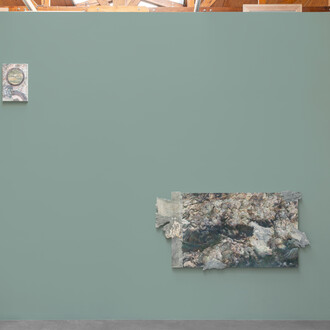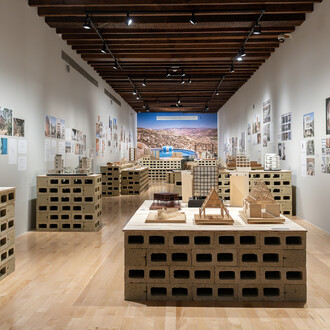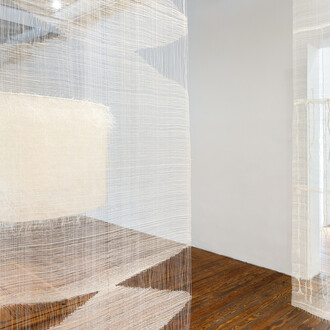After remaining concealed throughout the night, sunlight gently illuminates the verdant flora that thrives on Tzompol hill, situated within the rugged landscape of Xochimilco in Mexico City. The first streaks of blue in the sky are accompanied by sounds, the dawn chorus that occurs when birds hail the morning. As day breaks, the scene is revealed, displaying a variety of flora and fauna. The Mexican artist Alejandra Venegas works in her studio and home, which is located in close proximity to the slopes of the hill. Titled Tzompolo Daybreak, this exhibition presents a selection of the artist's recent sculptural works, exploring themes of daybreak and new beginnings. The exhibition reveals a consistent theme across the artist's work, where natural elements, landscapes, and a cyclical, rhythmic conception of time are in harmony with a material and visual exploration of color.
The landscape painter and writer Gilles Clement has described gardens as fenced-off spaces dedicated to protecting the vegetables, fruits, flowers, and animals that come together in it. The thematic corpus of Venegas’s reliefs, paintings, and drawings begins in the vegetable garden located at the center of her house, an area that is home to plant and animal species, grasshoppers and butterflies that temporarily inhabit this space. There the artist grows aromatic herbs, flowers, and a chayote plant that has sprawled the length and breadth of the outdoor space where she works each day on the wooden reliefs. This garden is a small ecosystem that serves the artist as a workspace, but also as a space for observing the various cyclical processes of nature: the coming of the rains, the sprouting of plants, and the arrival of a variety of insects that feed on them. It is precisely this visual universe that appears in the reliefs, paintings, and drawings made by the artist: the twisting tendrils of a chayote vine, lines marked by the grasshoppers’ abdomens, and leaves pierced by the insects’ pincers.
The sculptures and reliefs carved by Alejandra Venegas on different kinds of wood have a very direct connection with materiality. Wood tends to play a leading role in carving because of its hardness, porousness, and tonality, which is why Venegas chooses a color palette as a function of the type of material (watercolor or oil), while bearing in mind that the organic surface of wood absorbs more of the pigments than fabric canvas does when used as a support medium for painting. The use of certain types of painting and the choice of colors are important parts of her creative process, for even though it might seem that these were intuitive, personal decisions, the artist naturally expresses a treatment of color. For example, the relief titled Albor Tzompol (Tzompol daybreak, 2025) evokes a flock of birds descending from the sky represented by large spirals of air. This piece, painted with black oil, reveals Venegas’s exploration of monochrome, while simultaneously referring to the early dawn at the precise moment when the sky begins to lighten.
In the sculpture Chayote (2025), Venegas represents the stalks of a chayote plant in bas relief by carving furrows that she then paints with watercolor in blue-green tones, leaving much of the surface in the natural color of the wood. This resource, by no means unfamiliar to the artist, has been used throughout the history of wood carving and can be seen in both reliefs and sculptures from the Viceregal period, prior to Mexican Independence. The exhibition also includes reliefs that showcase the artist’s bid to see the bodies of invertebrate animals as landscapes. Such is the case of Cerros (Hills, 2025), a work that makes clear the relationship between the morphology of grasshoppers’ bodies—specifically their thoraxes—and the topography of mountain terrain. The bodies of these insects, seen as if through a macro lens (to borrow the language of photography), can reveal a vibrant landscape in carmine, bright blue, and orange. In the piece En el cerro de los chapulines (On grasshopper hill, 2025), Venegas does the same exercise, presenting the makeup of a grasshopper’s hind legs, exactly where the femur meets the tibia, to suggest a mountainous landscape.
Insects play a leading role in the thematic dimension of Alejandra Venegas’ work because they live in her garden. We see them piled up in pieces like Clorofila (Chlorophyll, 2025), a relief showing five grasshoppers on top of each other in a vertical composition that follows the form of the wood. She thus makes clear that the garden fulfills a dietary function not only for human beings, but also for other animals.
Every hand-carved relief brings with it a variety of elements: it implies a sonorousness and a rhythm marked by the gouge striking the wood. It goes without saying that this exercise also involves the body and its senses, both internal (given by proprioception) and external (touch, sight, hearing, and even smell). The artist’s body becomes a vehicle for movement and rhythm, merging with her technique and materials.
In this exhibition, Venegas also presents sculptures that feature tepozanes, a species of tree native to Mexico (Buddleja cordata), and jacaranda trees, a species introduced to Mexico City in the early twentieth century. Milpas are another recurring thematic element in Alejandra Venegas’s sculptures, reliefs, and paintings. These works, too, refer to the garden as a workspace, aside from being a place for rest and contemplation.
Tzompol daybreak also features Alejandra Venegas' latest pictorial work, showcasing pieces that depict her immediate surroundings and demonstrate her adeptness in handling color. These oil paintings are distinguished by their use of long, wide brushstrokes, which create a textured effect. They are also notable for their use of a light palette with brilliant tones, reminiscent of the forested landscapes of Ernst Ludwig Kirchner or Edvard Munch's landscape of Kragerø. Venegas draws on the natural elements that surround her daily life, encouraging spectators to explore the expressive possibilities of painting. The landscape is characterized by milpa, maize and crop-surrounding vegetation. The chayote plant reappears, this time accompanied by its fruits and a complex array of flora, which draws the viewer into the artist's imagination due to its rich color variety.
Alejandra Venegas’ creative process for interweaving painting and sculpture begins with attentive contemplation of the elements that make up her garden. She supplements this initial observation with hikes along nearby trails, photographic documentation, and occasionally printing one or more of the photographs she takes. Next comes the line, the solid basis of drawing, which unwinds itself in different support media: canvas or wood. Each such medium marks a subtle border between disciplines, and thereby defines the tools needed: a paintbrush for canvas, a gouge for wood. On canvas, the line becomes a brushstroke; in wood, a carved incision. Tzompol daybreak reveals this shifting between techniques, showing how Venegas conceives the garden, how she explores her surroundings, and how she makes use of diverse resources in order to sculpt and paint interchangeably.
















